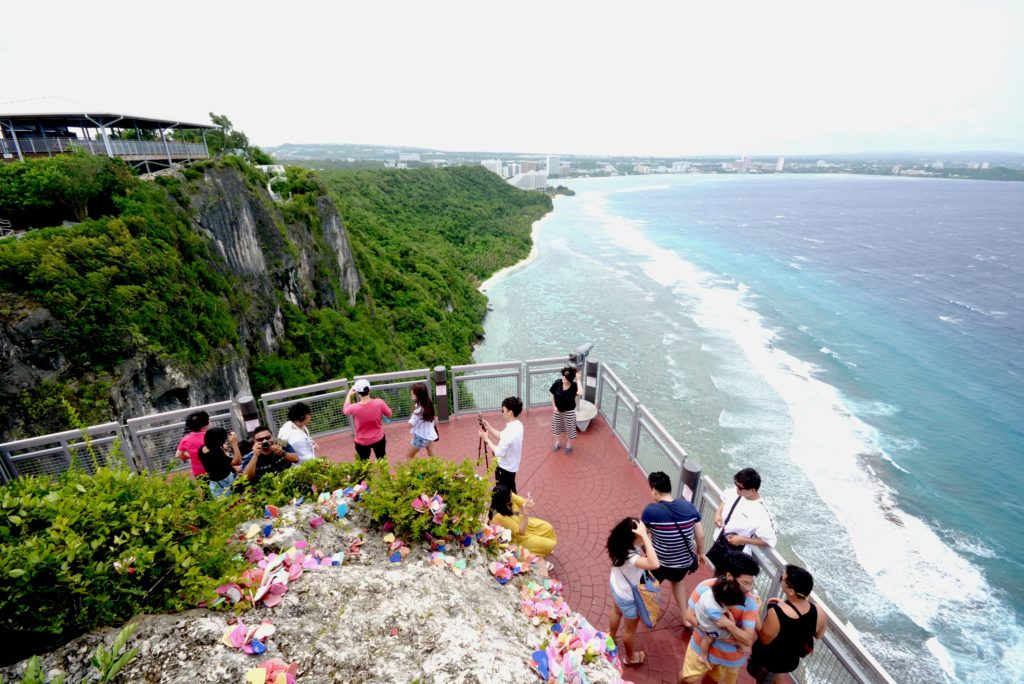
LOCKS OF LOVE. Puntan Dos Amantes or Two Lovers Point, a cliff line towering over Tumon Bay in the northern part of the island, offers a spectacular view of Guam.
Guam offers visitors more than couture browsing and shopping for all budgets. This relatively easy to navigate island laid out in a radius of cliffs and coasts, hills and highways will equally delight the nature lover, history buff and food enthusiast.
Major roads are signposted with routes to most destinations.
Maps can be picked up at hotels or tourist centers. This, along with walking tour itineraries and guides
to tour the island.
But you’ll obviously be stopping and want to see the places properly, so why not make a half-day or full-day trip out of it?
ISLAND SHOWS. A visual feast of energy and excitement. Be sure to keep your camera ready to capture the varied faces and facets of Guam.
Despite its small size (544 sq km) and population (currently at 164,761), the US Territory of Guam is incredibly multicultural. You’ll feel right at home here after realizing that many kababayans work in hotels, shops, clubs… virtually all over.
ROCK OF AGES. A symbol of Chamorro strength, pride, resistance, and survival is the latte, a megalithic structure used to elevate houses in the pre-colonial period. First built around 800 C.E., latte stones are large coral blocks composed of a trapezoidal stone pillar called a “haligi,” and a hemispherical cap called a “tasa.” Jungle areas and sites in which latte stones are located are considered sacred. In precolonial years, people buried family members beneath latte stones and thus ancestral spirits are assumed to reside there. (Location: Valley of the Latte Adventure Park)
The second largest ethnic group in Guam next to its indigenous people, the Chamorros, are Filipinos.
These young Pinoys, even if they hardly speak our language, will pepper their interactions with “poh” and “opoh.”
TIES THAT BIND
As with other Pacific islanders, Filipinos and Chamorros shared indigenous cultural and colonial histories long before pre-colonial times.
Year 1521, Portuguese explorer Ferdinand Magellan, leading the Spanish expedition to the East Indies, landed at Guam on March 6 to replenish their foot supplies before sailing to the Philippines on March 16 where he met his end at the hands of native chieftain, Lapu-Lapu.
An obelisk marks the spot where Ferdinand Magellan landed in Guam
(Location: Umatac Bay, south of Guam)
After the defeat of Spain in the Spanish-American War of 1898, Guam and the Philippines both fell under American rule.
During World War 2, the Japanese occupation of the Philippines occurred between 1942 and 1945, while Guam’s was the period between 1941 and 1944.
The Sand Castle Show is billed as the best showin Guam. Beautiful dancers, awesome acrobatics,
incredible magic.
Through the years, Guam’s Filipino population continued to grow.
Ties remain strong and in any event, fiestas especially, the Pinoy community is large enough to satisfy yearnings of home.
Puntan Dos Amantes, is one of Guam’s most iconic attractions. The imposing metal sculpture of two
lovers is by renowned Filipino sculptor Eduardo Castrillo, the same artist behind the People Power monument in EDSA and the Heritage of Cebu monument in Parian Park, Cebu City.
Photo: Charo Logarta-Lagamon
* * *
Cebu Pacific flies to Guam every every Tuesday, Thursday, Saturdayand Sunday. For bookings and inquiries, go to www.cebu.pacificair.com or call the reservation hotlines (02) 7020-888 or (032) 230-8888.
* * *
There is never a shortage of adventures in Guam. For more information about Guam or suggestions to plan the perfect trip, go to www.visitguam.org or www.guamvisitorsbureau.com.
* * *
The three-day stay in Guam was courtesy of Cebu Pacific and the Guam Visitors Bureau.